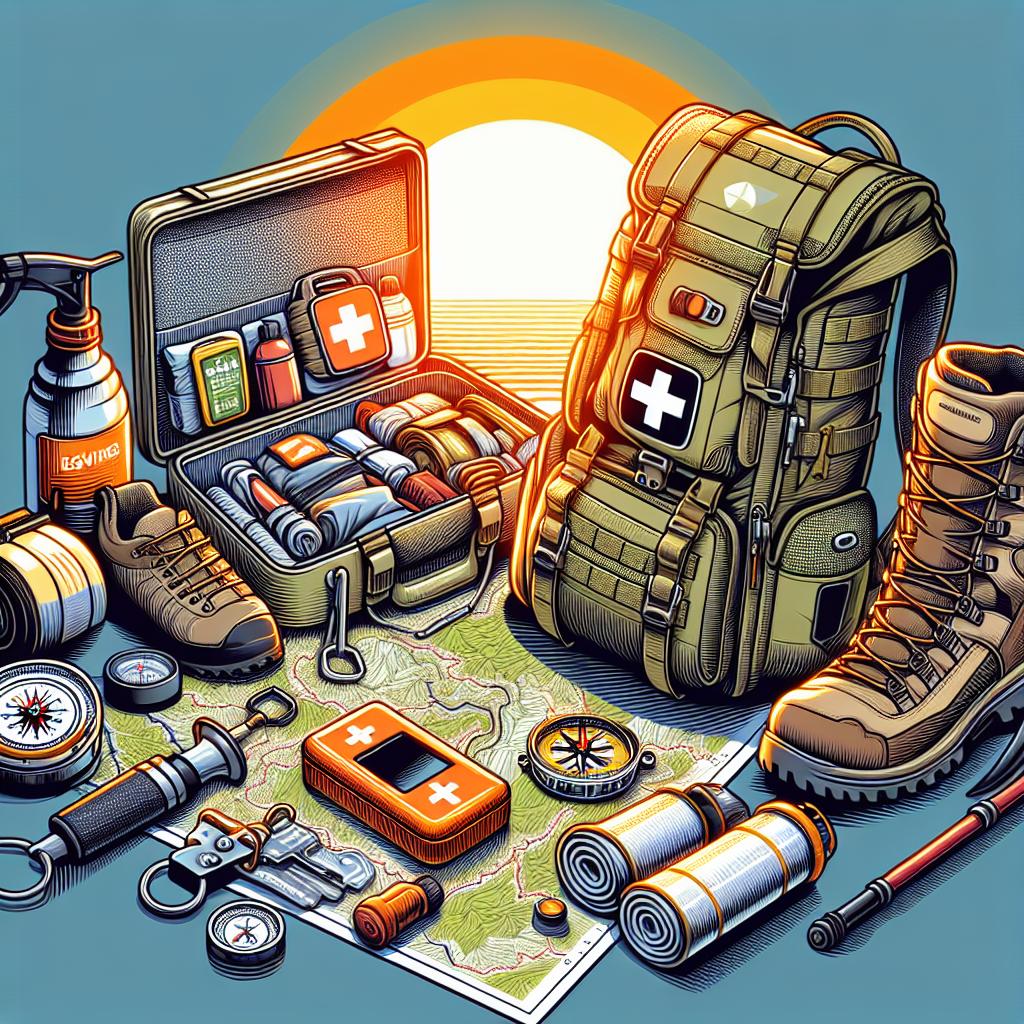Whispers of adventure weave through the ancient forests of the Great Smoky Mountains, where trails lead wanderers deep into the heart of nature’s wild embrace. Meandering streams, born from hidden springs, glisten like sapphire threads in the woven tapestry of the woods, inviting hikers to tread their waters. But these streams, with their unpredictable flows and slippery stones, often pose a formidable challenge, turning a tranquil journey into a test of resolve and resourcefulness. Whether you are a seasoned trailblazer or a curious novice, mastering the art of tackling these watery crossings is essential. Join us as we delve into the secrets of navigating these natural hurdles, ensuring your trek through the Smokies is not only safe but supremely satisfying.
Understanding Stream Characteristics
When embarking on a hiking adventure in the Smokies, it’s crucial to familiarize yourself with various stream characteristics, as they can drastically affect your crossing strategy. Streams in these mountains exhibit different features based on the season, weather conditions, and geography. During spring and after heavy rains, streams may swell significantly, making them more hazardous to traverse. Conversely, in dry periods, water levels may be low, exposing slippery rocks and uneven surfaces. Understanding these fluctuations helps you prepare adequately. Recognize that mountain streams can be subject to flash floods, which can turn a seemingly safe passage into a dangerous endeavor within minutes. Keeping an eye on weather forecasts and adjusting your plans accordingly is key to ensuring a safe crossing.
Specific characteristics like water depth, flow rate, and stream bed composition must also be considered. Streams with deep water and a strong current can be particularly treacherous. Identifying safer crossing points usually involves looking for wider, shallower sections with slower-moving water. It’s also helpful to observe the stream bed material—sections with large, stable rocks may offer more secure footing compared to those with loose gravel or sand. Here are a few tips to aid your navigation:
- **Look for natural bridges** like fallen trees or sturdy rocks that provide stable surfaces.
- **Use trekking poles** to gauge water depth and stability of the stream bed.
- **Cross at an angle**, moving slowly and facing upstream to counteract the current.

Essential Gear for Safe Crossings
When preparing for a stream crossing in the Smokies, having the right gear can make all the difference between a safe passage and a risky venture. Your essential kit should include trekking poles for better balance and stability. They act like a third and fourth leg, making it easier to gauge the depth of the water and the strength of the current. Additionally, high-quality waterproof boots or sturdy water shoes can protect your feet from sharp rocks and provide better traction underwater. Don’t underestimate the value of a well-designed backpack with a waterproof cover to keep your essentials dry and ensure you maintain agility.
Another crucial item is a well-fitting Personal Flotation Device (PFD), especially for more treacherous crossings. It may seem like overkill, but safety always comes first. Depending on the season, a wetsuit or dry suit could also be beneficial as it helps to regulate your body temperature and adds a layer of protection. Always pack a first aid kit tailored to water-based injuries—think waterproof dressings and a thermal blanket. Lastly, keep a weatherproof map and compass handy to ensure you don’t lose your way after a challenging crossing. Here’s a quick gear checklist for your next stream crossing:
- Trekking Poles
- Waterproof Boots or Water Shoes
- Backpack with Waterproof Cover
- Personal Flotation Device (PFD)
- Wetsuit or Dry Suit
- First Aid Kit (waterproof)
- Weatherproof Map and Compass

Techniques for Managing Strong Currents
Strong currents can pose serious risks during stream crossings, but with the right techniques, you can enhance your safety and confidence. One effective strategy is to use a tripod stance with your trekking poles. Plant one foot firmly on the streambed and use both poles to form a stable triangular base. This stance helps distribute your weight more evenly and provides additional support against the current’s force. Additionally, consider crossing at a diagonal angle upstream; this allows the current to assist you by pushing against you rather than knocking you off balance.
Another essential tip is to always unbuckle your backpack waist strap. In case you slip or fall, an unbuckled pack can be easily discarded, freeing you from getting pinned underwater. If you’re crossing with a group, opt for the buddy system. Link arms and move in a synchronized manner—the additional points of contact help stabilize everyone involved. Remember to scout the area for a safer crossing spot. Look for wider, more shallow stretches with a slower current. Avoid narrow sections where currents tend to be strongest.
| Technique | Description |
|---|---|
| Tripod Stance | Use trekking poles to form a triangular base for stability. |
| Diagonal Crossing | Cross upstream at an angle to use the current for support. |
| Unbuckle Backpack | Ensures easy discard in case of a fall. |
| Buddy System | Link arms and synchronize movements for added stability. |
| Scout Ahead | Find wider, shallower areas with slower currents. |

Tips for Maintaining Balance and Stability
The first step to maintaining balance and stability during challenging stream crossings is to use proper footing. **Scout ahead** to identify secure rocks or logs that you can step on. Avoid slippery or wobbly surfaces that can throw you off balance. Wear hiking shoes with a good grip to prevent slipping. If you have trekking poles, plant them firmly in the stream bed before each step; they can act as extra “legs” to keep you steady.
**Body posture** is another critical element. Keep your knees slightly bent to lower your center of gravity, which enhances balance. Maintain a slight forward lean as you cross to counteract the pull of the stream’s current. Avoid rushing; slow and deliberate movements will keep you more stable. Distribute your weight evenly, especially when carrying a heavy backpack. If needed, work with your hiking buddies to form a human chain for added stability, where everyone holds onto the next person’s pack or arm.
Q&A
Q: What preliminary steps should hikers take before attempting to cross a stream in the Smokies?
A: Before attempting to cross any stream, hikers should first scout the area and assess the stream’s current conditions. Look for the shallowest and most stable section, ideally where the water flow is slower. Research and check weather reports for rainfall or potential floods, and ensure to inform someone about your plans and expected return time.
Q: Are there specific tools or gear recommended for stream crossings?
A: Yes, several items can greatly enhance safety and comfort during stream crossings. Waterproof boots or sturdy, non-slip water shoes are essential. Trekking poles provide added stability and support. A waterproof bag or dry sack will keep your gear dry if you happen to slip. Additionally, carrying a rope can be handy for added balance or to assist fellow hikers.
Q: What are the key tips for maintaining balance while crossing a stream?
A: To maintain balance, face upstream and use trekking poles to steady yourself. Make deliberate, small steps and always have at least two points of contact with the streambed—your feet and a pole, for instance. Bend your knees slightly to lower your center of gravity, and avoid crossing if the water is above your knees.
Q: How should hikers deal with strong currents when crossing a stream?
A: In the presence of strong currents, hike upstream at a slight angle rather than directly across. This minimizes resistance and allows you to respond better to the flow. Always unbuckle the waist and chest strap of your backpack to make it easier to remove in an emergency.
Q: Are there any seasons or conditions when stream crossings become particularly dangerous?
A: Yes, stream crossings are particularly risky during and immediately after heavy rains or during snowmelt in spring. Early mornings, when water levels are usually lower, are safer times for crossing. However, if water levels seem too high or currents too fast, it’s always wiser to turn back and find an alternative route.
Q: What should hikers do if they lose their footing and fall in the stream?
A: If you fall, don’t panic. Immediately try to float on your back with your feet pointed downstream to protect your head from rocks. Use your arms to navigate toward the shore and exit the stream as safely and quickly as possible. Regroup, dry off, and reassess your gear and plans before continuing.
Q: Are there any wilderness skills that could be specifically useful for stream crossings?
A: Indeed, basic swimming skills and understanding water dynamics are incredibly beneficial. Familiarity with rope techniques, such as how to set up a hand line across the stream, can also be useful. Additionally, knowing how to read the landscape and spot potential hazards can significantly improve your safety.
Q: What is the best way to prepare for unexpected stream crossings on a hiking trip in the Smokies?
A: The best way to prepare is by practicing beforehand in a controlled environment. Familiarize yourself with the gear, learn from experienced hikers or take a course that covers water safety. Always stay flexible in your plans and ready to reassess based on real-time conditions. Safety should always be the top priority.
By following these guidelines and remaining cautious, hikers can confidently tackle the challenging stream crossings of the Smokies and safely enjoy the beauty of the trails.
Key Takeaways
As you venture through the mesmerizing trails of the Great Smoky Mountains, remember that the journey is as significant as the destination. Conquer those daunting stream crossings not just with grit, but with a blend of knowledge and respect for nature’s whimsy. Each crossing isn’t merely an obstacle, but a dance with the untamed beauty of the Smokies, setting the rhythm for your adventure. So, lace up your boots, steady your heart, and let the mountain streams guide you to stories worth sharing. Happy trails, intrepid explorers, and may every crossing bring a tale of courage and wonder.

